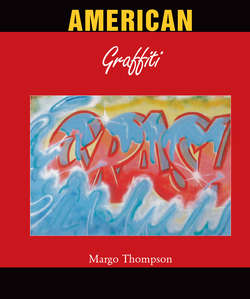Читать книгу American Graffiti - Margo Thompson - Страница 21
На сайте Литреса книга снята с продажи.
Subway Writers
LEE
ОглавлениеOf the graffiti writers who moved from subway to studio to produce permanent paintings on canvas, LEE was among the most accomplished. He would go to the Brooklyn Bridge subway station to see the trains he had tagged in the yards where they had been parked overnight, and to gauge the reaction of subway riders on the platform.[107] Early in his career, he downplayed the tag in his whole-car masterpiece in favour of images that represented an idea. His first effort to this end was the 1976 ‘Doomsday’ train. Jack Stewart described the two-car design as ‘a rambling pictorial composition of tilting tenements, flames, and a threatening horned alien monster’.[108] Subway riders themselves were LEE’s subject in the 1977 train ‘The Straphangers’, where the exterior of the car has dissolved to reveal the standing passengers crammed inside.[109]
LEE incorporated political content into his pieces more often than other writers. In 1979, his ‘Stop the Bomb’ train pleaded for a resolution to the Cold War. Above the title, rendered in drab-coloured but legible bubble letters, floated two clouds in dark and light green. One was labeled ‘U.S.A.’, the other ‘Russia U. S. S.R.’, and a hand emerged from each one to clasp in the middle. The handshake was located on the centre pair of subway doors so that the hands separated and came together when the doors opened and shut. At the right, a missile over buildings and trees was labeled ‘War is selfish death’. The composition continued on a second car, linked by an urban skyline in front of which sat a weeping figure. To the left of the figure, LEE was painted top-to-bottom and an inscription read, ‘If we the people of today destroy its beauty before they ever see it’. The text was ambiguous, referring either to the earth’s beauty threatened by Cold War destruction, or to writing which could be scrubbed off the train at any time. By the time he painted this pair of cars, LEE’s handiwork dominated the 5 line which ran the length of Manhattan under Lexington Avenue to the Bronx.
In the late 1970s, LEE painted the walls of outdoor handball courts near the Smith Housing Projects where he lived. In these murals, he devised narratives that attested to the power of writing: cartoon characters that visibly responded to LEE’s tag written beside them. In one, a lion sat on his haunches in front of a cinderblock wall. A candle cast a glow on the wall, where LEE painted his tag in blue letters, crisply outlined and highlighted in white. The lion’s roar matched the ferocity of the tag. In the upper right corner, LEE wrote, ‘There is only one reason for art to know that you are alive’, and signed it with a flourish. In another mural, Howard the Duck, a figure borrowed from Marvel comics, cowered behind a trash-can lid warding off LEE’s tag. The letters were shaped like thunderbolts, green against an orange-red splash, and Howard’s reaction, like the lion’s roar, registered the writer’s power.
The handball court murals precipitated LEE’s career as a painter in addition to burnishing his reputation as an accomplished, ambitious writer. They attracted the notice of Fred Brathwaite, who contacted LEE and offered to represent him in pursuing mural commissions. Brathwaite posed in front of LEE’s Howard the Duck mural for a short article in the Village Voice in February 1979. There, he identified himself as FAB FIVE FREDDY after the name of LEE’s former crew. The services he offered were the ‘purest form of New York art’, authentic subway graffiti. He also dropped the names of artists the Voice reader would likely know: ‘As you can see, we’ve obviously been influenced by Warhol, Crumb, and Lichtenstein’.[110] One such reader was the Italian businessman and director of the Giorgio de Chirico estate, Claudio Bruni, who would eventually introduce Sam Esses to graffiti art. He contacted LEE and FAB FIVE FREDDY, and arranged a gallery exhibition for them in Italy.[111]
LAC, CEL, and LED, Martin Luther King, 1984. Aerosol paint on brick wall. Manhattan, New York.
LEE, Love Sick Bomber, 1979. Aerosol paint on subway car.
LEE, Sherlock, 1978. Aerosol paint on subway car.
107
Hoekstra, ed., 177.
108
Stewart, 465.
109
Stewart, 472, 475.
110
Howard Smith and Cathy Cox, “Scenes,” Village Voice, 12 February 1979.
111
Miller, 158; Henry Chalfant and James Prigoff, Spraycan Art (London: Thames and Hudson, 1987), 7.
